CAM411A Literature Review Proposal: Phytoestrogens and Breast Cancer
VerifiedAdded on 2022/09/09
|21
|5254
|12
Literature Review
AI Summary
This literature review proposal examines the potential of phytoestrogens, naturally occurring compounds found in plants, as a therapeutic intervention for breast cancer. The proposal outlines the condition of breast cancer, including its prevalence, etiology, pathophysiology, and conventional medical treatments. It then focuses on phytoestrogens, detailing their background, actions, and mechanisms of action, particularly their estrogen-like effects and potential to influence breast cancer progression. The proposal includes aims, objectives, and a research question framed using the PICO format. A methodology is described for reviewing and analyzing existing literature on the topic. The proposal also includes findings from existing literature, discussing the impact of phytoestrogens on breast cancer cells, the selectivity of phytoestrogens towards estrogen receptors, and the influence of phytoestrogen concentrations on tumor growth. It also explores the effects of phytoestrogens on menopause symptoms in breast cancer patients, the efficacy of soy-based phytoestrogens in managing hot flashes, and the role of phytoestrogens in estrogen synthesis and breast cancer development. The proposal also references several key studies and their findings on phytoestrogens and breast cancer.
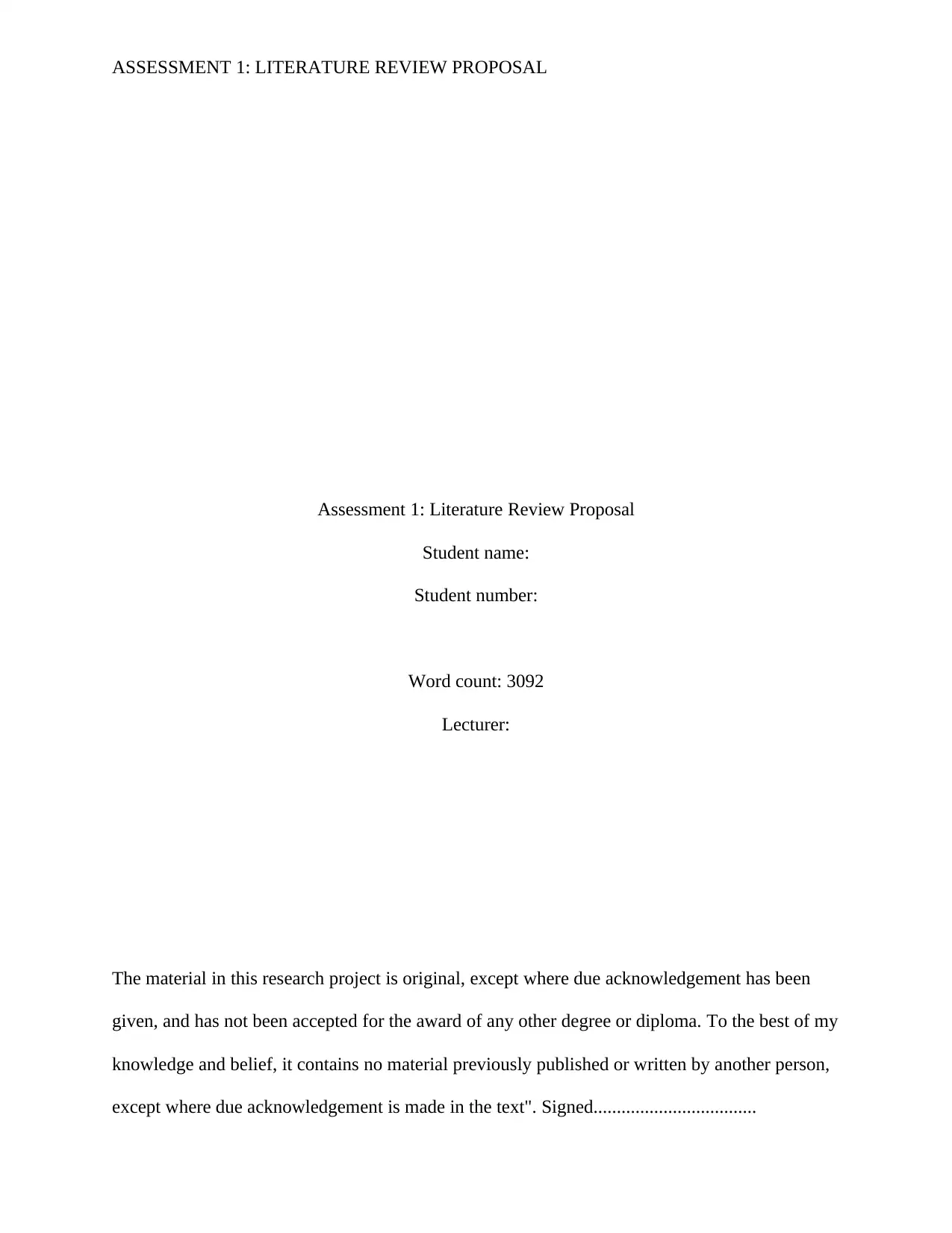
ASSESSMENT 1: LITERATURE REVIEW PROPOSAL
Assessment 1: Literature Review Proposal
Student name:
Student number:
Word count: 3092
Lecturer:
The material in this research project is original, except where due acknowledgement has been
given, and has not been accepted for the award of any other degree or diploma. To the best of my
knowledge and belief, it contains no material previously published or written by another person,
except where due acknowledgement is made in the text". Signed...................................
Assessment 1: Literature Review Proposal
Student name:
Student number:
Word count: 3092
Lecturer:
The material in this research project is original, except where due acknowledgement has been
given, and has not been accepted for the award of any other degree or diploma. To the best of my
knowledge and belief, it contains no material previously published or written by another person,
except where due acknowledgement is made in the text". Signed...................................
Paraphrase This Document
Need a fresh take? Get an instant paraphrase of this document with our AI Paraphraser
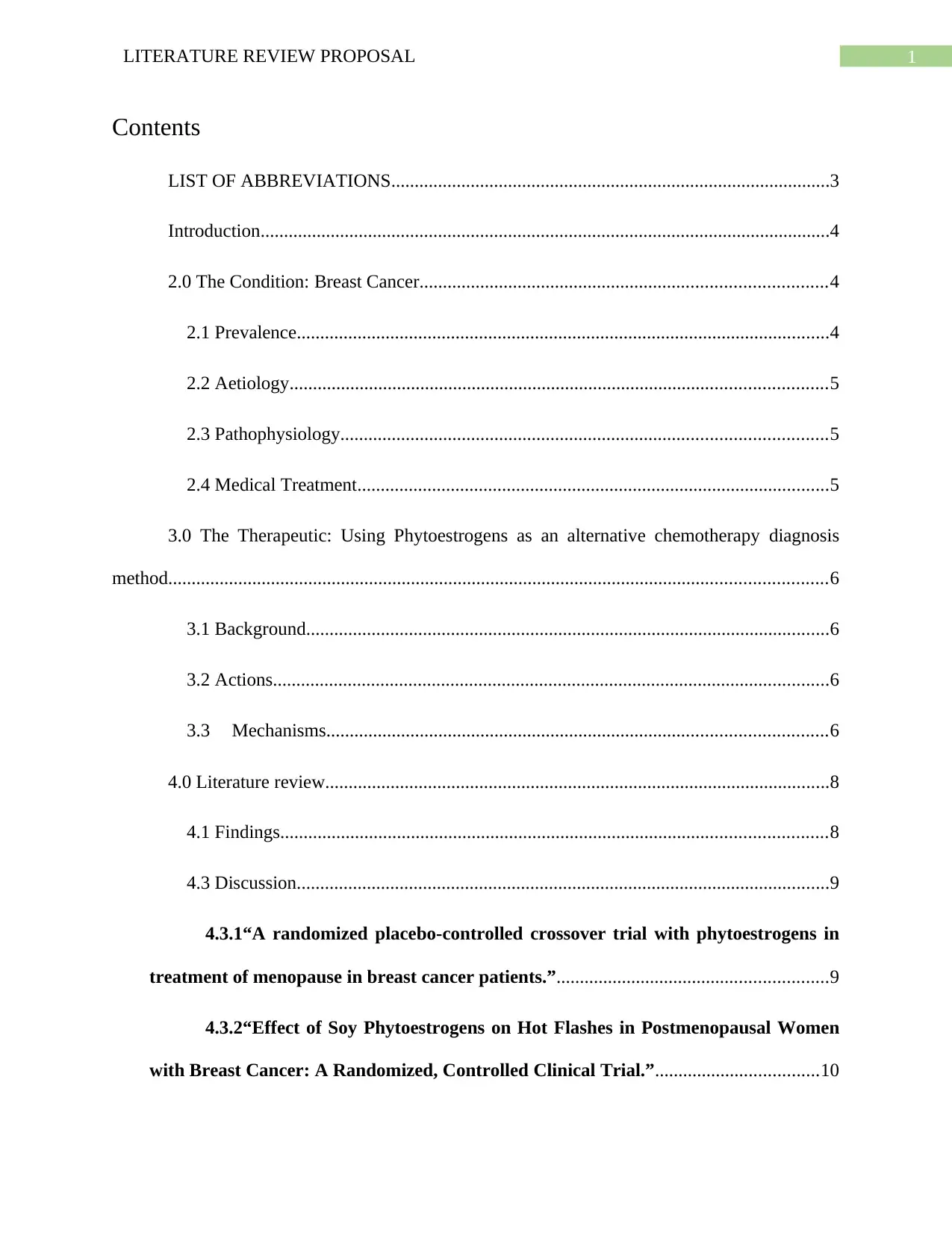
1LITERATURE REVIEW PROPOSAL
Contents
LIST OF ABBREVIATIONS..............................................................................................3
Introduction..........................................................................................................................4
2.0 The Condition: Breast Cancer.......................................................................................4
2.1 Prevalence..................................................................................................................4
2.2 Aetiology...................................................................................................................5
2.3 Pathophysiology........................................................................................................5
2.4 Medical Treatment.....................................................................................................5
3.0 The Therapeutic: Using Phytoestrogens as an alternative chemotherapy diagnosis
method.............................................................................................................................................6
3.1 Background................................................................................................................6
3.2 Actions.......................................................................................................................6
3.3 Mechanisms...........................................................................................................6
4.0 Literature review............................................................................................................8
4.1 Findings.....................................................................................................................8
4.3 Discussion..................................................................................................................9
4.3.1“A randomized placebo-controlled crossover trial with phytoestrogens in
treatment of menopause in breast cancer patients.”..........................................................9
4.3.2“Effect of Soy Phytoestrogens on Hot Flashes in Postmenopausal Women
with Breast Cancer: A Randomized, Controlled Clinical Trial.”...................................10
Contents
LIST OF ABBREVIATIONS..............................................................................................3
Introduction..........................................................................................................................4
2.0 The Condition: Breast Cancer.......................................................................................4
2.1 Prevalence..................................................................................................................4
2.2 Aetiology...................................................................................................................5
2.3 Pathophysiology........................................................................................................5
2.4 Medical Treatment.....................................................................................................5
3.0 The Therapeutic: Using Phytoestrogens as an alternative chemotherapy diagnosis
method.............................................................................................................................................6
3.1 Background................................................................................................................6
3.2 Actions.......................................................................................................................6
3.3 Mechanisms...........................................................................................................6
4.0 Literature review............................................................................................................8
4.1 Findings.....................................................................................................................8
4.3 Discussion..................................................................................................................9
4.3.1“A randomized placebo-controlled crossover trial with phytoestrogens in
treatment of menopause in breast cancer patients.”..........................................................9
4.3.2“Effect of Soy Phytoestrogens on Hot Flashes in Postmenopausal Women
with Breast Cancer: A Randomized, Controlled Clinical Trial.”...................................10
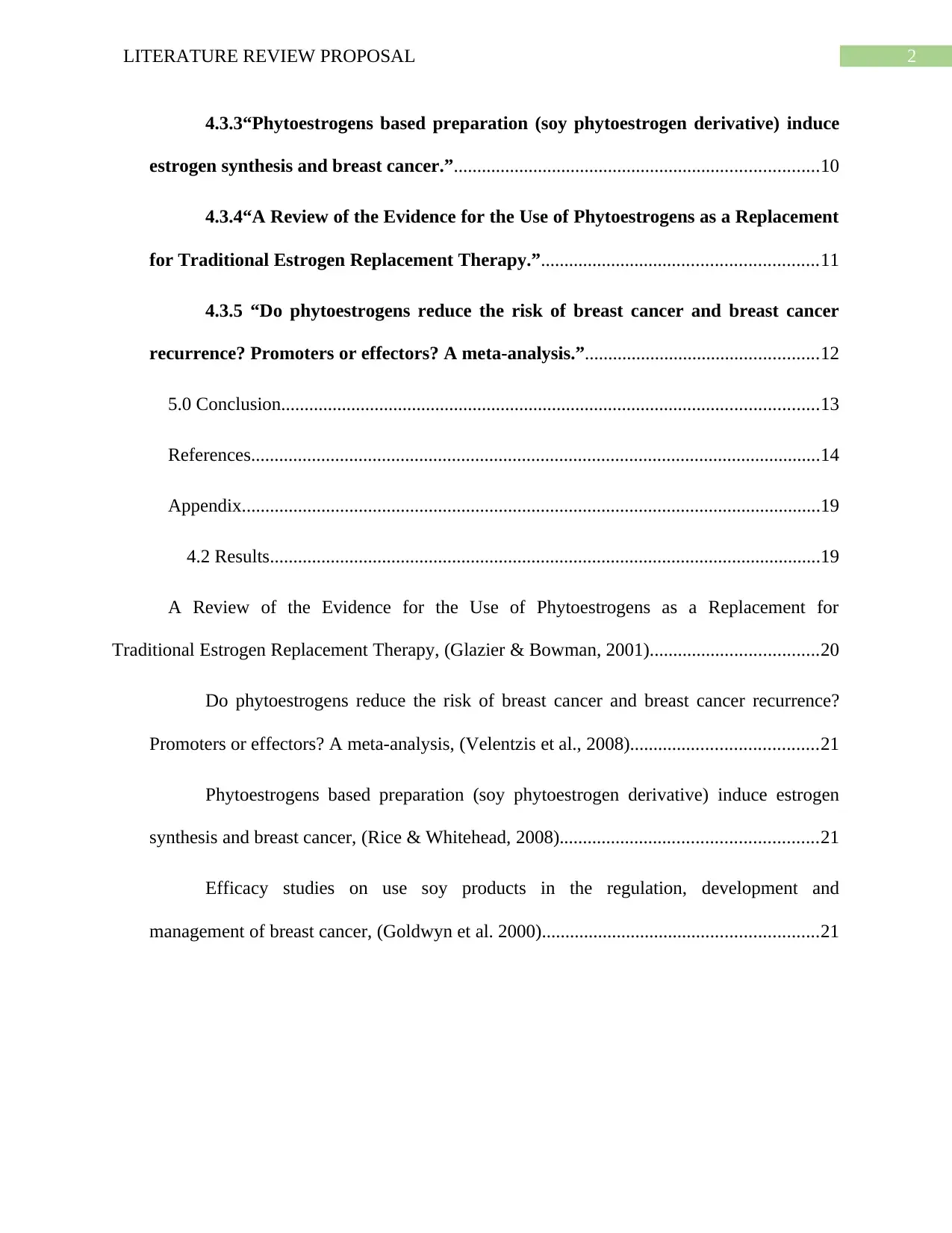
2LITERATURE REVIEW PROPOSAL
4.3.3“Phytoestrogens based preparation (soy phytoestrogen derivative) induce
estrogen synthesis and breast cancer.”..............................................................................10
4.3.4“A Review of the Evidence for the Use of Phytoestrogens as a Replacement
for Traditional Estrogen Replacement Therapy.”...........................................................11
4.3.5 “Do phytoestrogens reduce the risk of breast cancer and breast cancer
recurrence? Promoters or effectors? A meta-analysis.”..................................................12
5.0 Conclusion...................................................................................................................13
References..........................................................................................................................14
Appendix............................................................................................................................19
4.2 Results......................................................................................................................19
A Review of the Evidence for the Use of Phytoestrogens as a Replacement for
Traditional Estrogen Replacement Therapy, (Glazier & Bowman, 2001)....................................20
Do phytoestrogens reduce the risk of breast cancer and breast cancer recurrence?
Promoters or effectors? A meta-analysis, (Velentzis et al., 2008)........................................21
Phytoestrogens based preparation (soy phytoestrogen derivative) induce estrogen
synthesis and breast cancer, (Rice & Whitehead, 2008).......................................................21
Efficacy studies on use soy products in the regulation, development and
management of breast cancer, (Goldwyn et al. 2000)...........................................................21
4.3.3“Phytoestrogens based preparation (soy phytoestrogen derivative) induce
estrogen synthesis and breast cancer.”..............................................................................10
4.3.4“A Review of the Evidence for the Use of Phytoestrogens as a Replacement
for Traditional Estrogen Replacement Therapy.”...........................................................11
4.3.5 “Do phytoestrogens reduce the risk of breast cancer and breast cancer
recurrence? Promoters or effectors? A meta-analysis.”..................................................12
5.0 Conclusion...................................................................................................................13
References..........................................................................................................................14
Appendix............................................................................................................................19
4.2 Results......................................................................................................................19
A Review of the Evidence for the Use of Phytoestrogens as a Replacement for
Traditional Estrogen Replacement Therapy, (Glazier & Bowman, 2001)....................................20
Do phytoestrogens reduce the risk of breast cancer and breast cancer recurrence?
Promoters or effectors? A meta-analysis, (Velentzis et al., 2008)........................................21
Phytoestrogens based preparation (soy phytoestrogen derivative) induce estrogen
synthesis and breast cancer, (Rice & Whitehead, 2008).......................................................21
Efficacy studies on use soy products in the regulation, development and
management of breast cancer, (Goldwyn et al. 2000)...........................................................21
⊘ This is a preview!⊘
Do you want full access?
Subscribe today to unlock all pages.

Trusted by 1+ million students worldwide
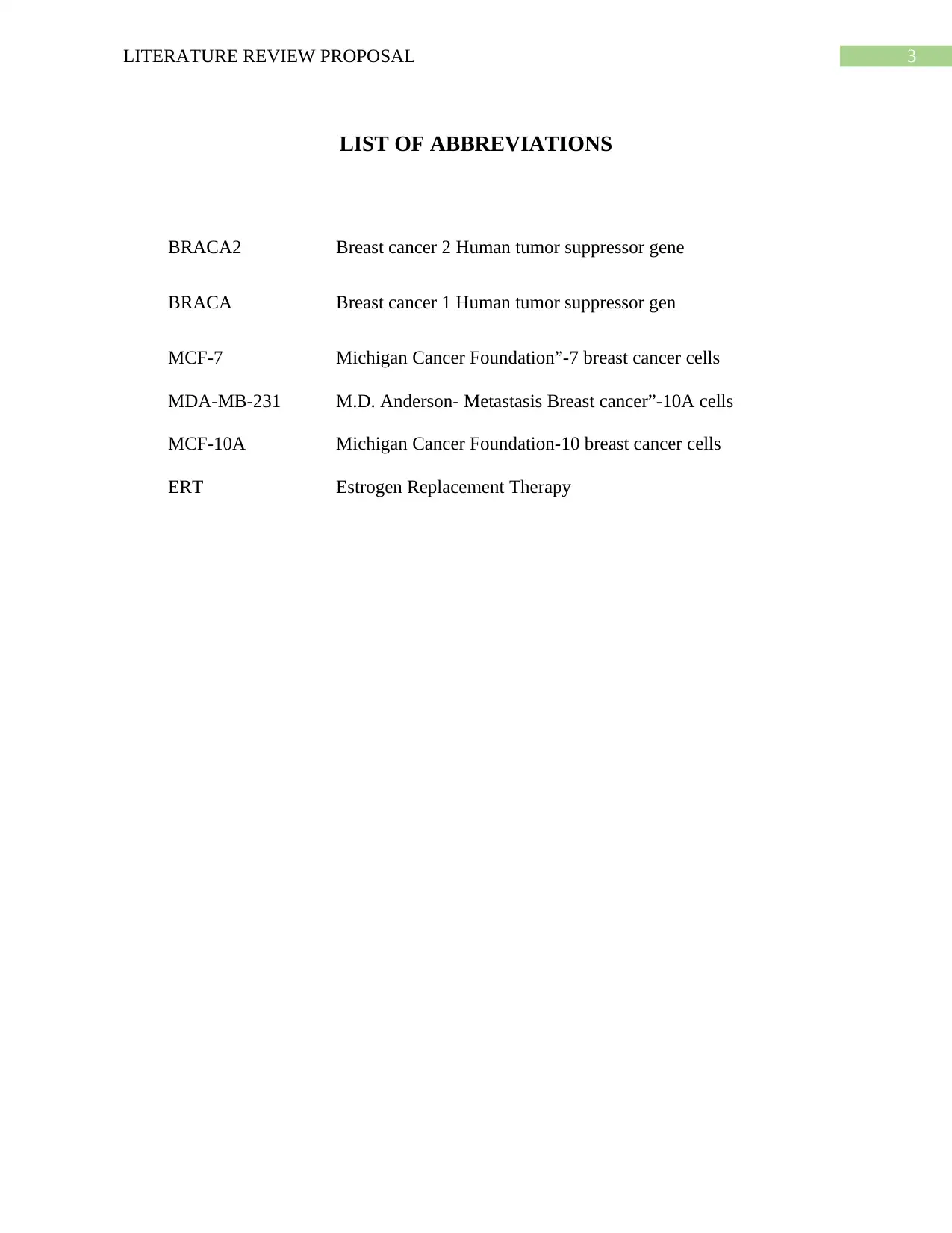
3LITERATURE REVIEW PROPOSAL
LIST OF ABBREVIATIONS
BRACA2 Breast cancer 2 Human tumor suppressor gene
BRACA Breast cancer 1 Human tumor suppressor gen
MCF-7 Michigan Cancer Foundation”-7 breast cancer cells
MDA-MB-231 M.D. Anderson- Metastasis Breast cancer”-10A cells
MCF-10A Michigan Cancer Foundation-10 breast cancer cells
ERT Estrogen Replacement Therapy
LIST OF ABBREVIATIONS
BRACA2 Breast cancer 2 Human tumor suppressor gene
BRACA Breast cancer 1 Human tumor suppressor gen
MCF-7 Michigan Cancer Foundation”-7 breast cancer cells
MDA-MB-231 M.D. Anderson- Metastasis Breast cancer”-10A cells
MCF-10A Michigan Cancer Foundation-10 breast cancer cells
ERT Estrogen Replacement Therapy
Paraphrase This Document
Need a fresh take? Get an instant paraphrase of this document with our AI Paraphraser
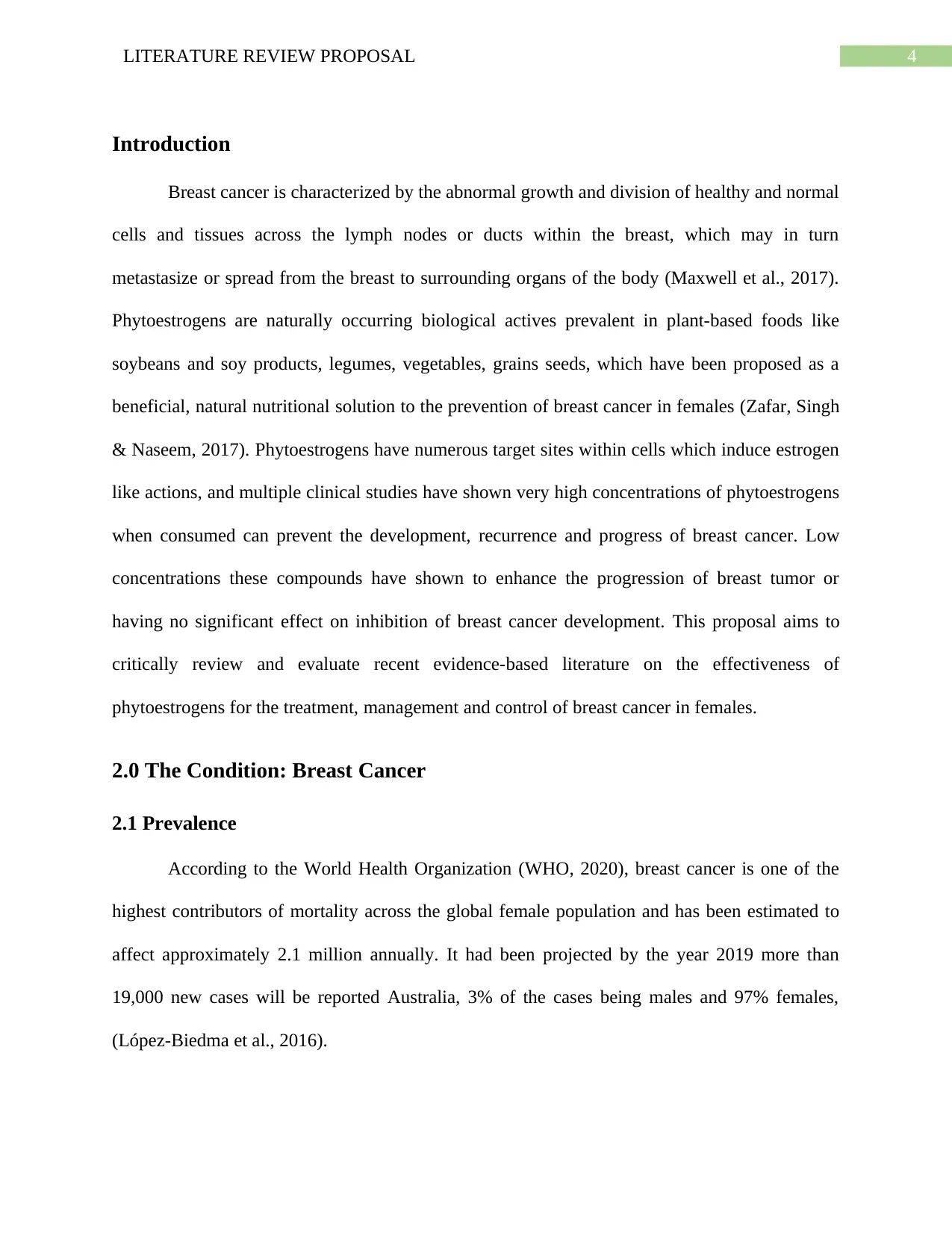
4LITERATURE REVIEW PROPOSAL
Introduction
Breast cancer is characterized by the abnormal growth and division of healthy and normal
cells and tissues across the lymph nodes or ducts within the breast, which may in turn
metastasize or spread from the breast to surrounding organs of the body (Maxwell et al., 2017).
Phytoestrogens are naturally occurring biological actives prevalent in plant-based foods like
soybeans and soy products, legumes, vegetables, grains seeds, which have been proposed as a
beneficial, natural nutritional solution to the prevention of breast cancer in females (Zafar, Singh
& Naseem, 2017). Phytoestrogens have numerous target sites within cells which induce estrogen
like actions, and multiple clinical studies have shown very high concentrations of phytoestrogens
when consumed can prevent the development, recurrence and progress of breast cancer. Low
concentrations these compounds have shown to enhance the progression of breast tumor or
having no significant effect on inhibition of breast cancer development. This proposal aims to
critically review and evaluate recent evidence-based literature on the effectiveness of
phytoestrogens for the treatment, management and control of breast cancer in females.
2.0 The Condition: Breast Cancer
2.1 Prevalence
According to the World Health Organization (WHO, 2020), breast cancer is one of the
highest contributors of mortality across the global female population and has been estimated to
affect approximately 2.1 million annually. It had been projected by the year 2019 more than
19,000 new cases will be reported Australia, 3% of the cases being males and 97% females,
(López-Biedma et al., 2016).
Introduction
Breast cancer is characterized by the abnormal growth and division of healthy and normal
cells and tissues across the lymph nodes or ducts within the breast, which may in turn
metastasize or spread from the breast to surrounding organs of the body (Maxwell et al., 2017).
Phytoestrogens are naturally occurring biological actives prevalent in plant-based foods like
soybeans and soy products, legumes, vegetables, grains seeds, which have been proposed as a
beneficial, natural nutritional solution to the prevention of breast cancer in females (Zafar, Singh
& Naseem, 2017). Phytoestrogens have numerous target sites within cells which induce estrogen
like actions, and multiple clinical studies have shown very high concentrations of phytoestrogens
when consumed can prevent the development, recurrence and progress of breast cancer. Low
concentrations these compounds have shown to enhance the progression of breast tumor or
having no significant effect on inhibition of breast cancer development. This proposal aims to
critically review and evaluate recent evidence-based literature on the effectiveness of
phytoestrogens for the treatment, management and control of breast cancer in females.
2.0 The Condition: Breast Cancer
2.1 Prevalence
According to the World Health Organization (WHO, 2020), breast cancer is one of the
highest contributors of mortality across the global female population and has been estimated to
affect approximately 2.1 million annually. It had been projected by the year 2019 more than
19,000 new cases will be reported Australia, 3% of the cases being males and 97% females,
(López-Biedma et al., 2016).
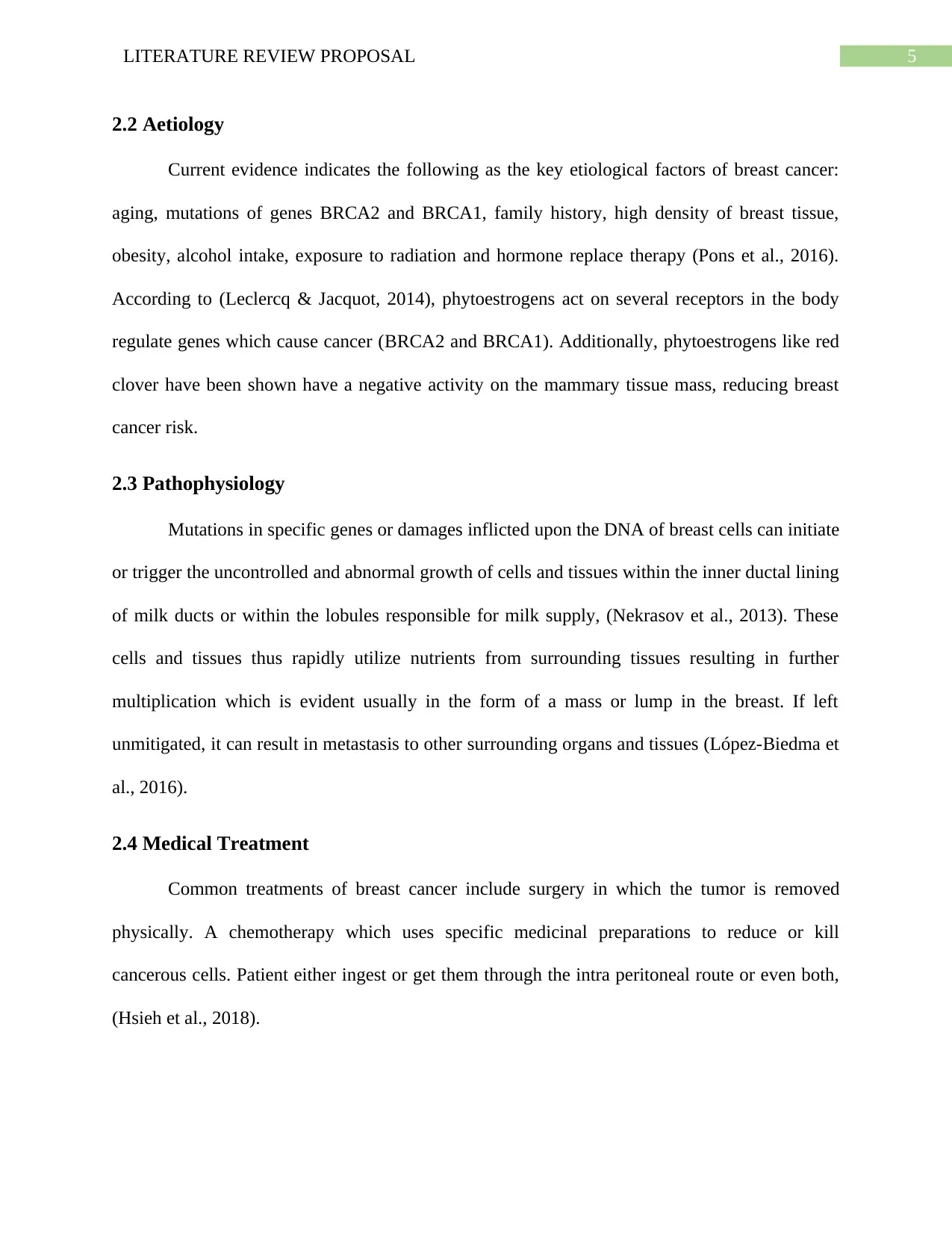
5LITERATURE REVIEW PROPOSAL
2.2 Aetiology
Current evidence indicates the following as the key etiological factors of breast cancer:
aging, mutations of genes BRCA2 and BRCA1, family history, high density of breast tissue,
obesity, alcohol intake, exposure to radiation and hormone replace therapy (Pons et al., 2016).
According to (Leclercq & Jacquot, 2014), phytoestrogens act on several receptors in the body
regulate genes which cause cancer (BRCA2 and BRCA1). Additionally, phytoestrogens like red
clover have been shown have a negative activity on the mammary tissue mass, reducing breast
cancer risk.
2.3 Pathophysiology
Mutations in specific genes or damages inflicted upon the DNA of breast cells can initiate
or trigger the uncontrolled and abnormal growth of cells and tissues within the inner ductal lining
of milk ducts or within the lobules responsible for milk supply, (Nekrasov et al., 2013). These
cells and tissues thus rapidly utilize nutrients from surrounding tissues resulting in further
multiplication which is evident usually in the form of a mass or lump in the breast. If left
unmitigated, it can result in metastasis to other surrounding organs and tissues (López-Biedma et
al., 2016).
2.4 Medical Treatment
Common treatments of breast cancer include surgery in which the tumor is removed
physically. A chemotherapy which uses specific medicinal preparations to reduce or kill
cancerous cells. Patient either ingest or get them through the intra peritoneal route or even both,
(Hsieh et al., 2018).
2.2 Aetiology
Current evidence indicates the following as the key etiological factors of breast cancer:
aging, mutations of genes BRCA2 and BRCA1, family history, high density of breast tissue,
obesity, alcohol intake, exposure to radiation and hormone replace therapy (Pons et al., 2016).
According to (Leclercq & Jacquot, 2014), phytoestrogens act on several receptors in the body
regulate genes which cause cancer (BRCA2 and BRCA1). Additionally, phytoestrogens like red
clover have been shown have a negative activity on the mammary tissue mass, reducing breast
cancer risk.
2.3 Pathophysiology
Mutations in specific genes or damages inflicted upon the DNA of breast cells can initiate
or trigger the uncontrolled and abnormal growth of cells and tissues within the inner ductal lining
of milk ducts or within the lobules responsible for milk supply, (Nekrasov et al., 2013). These
cells and tissues thus rapidly utilize nutrients from surrounding tissues resulting in further
multiplication which is evident usually in the form of a mass or lump in the breast. If left
unmitigated, it can result in metastasis to other surrounding organs and tissues (López-Biedma et
al., 2016).
2.4 Medical Treatment
Common treatments of breast cancer include surgery in which the tumor is removed
physically. A chemotherapy which uses specific medicinal preparations to reduce or kill
cancerous cells. Patient either ingest or get them through the intra peritoneal route or even both,
(Hsieh et al., 2018).
⊘ This is a preview!⊘
Do you want full access?
Subscribe today to unlock all pages.

Trusted by 1+ million students worldwide
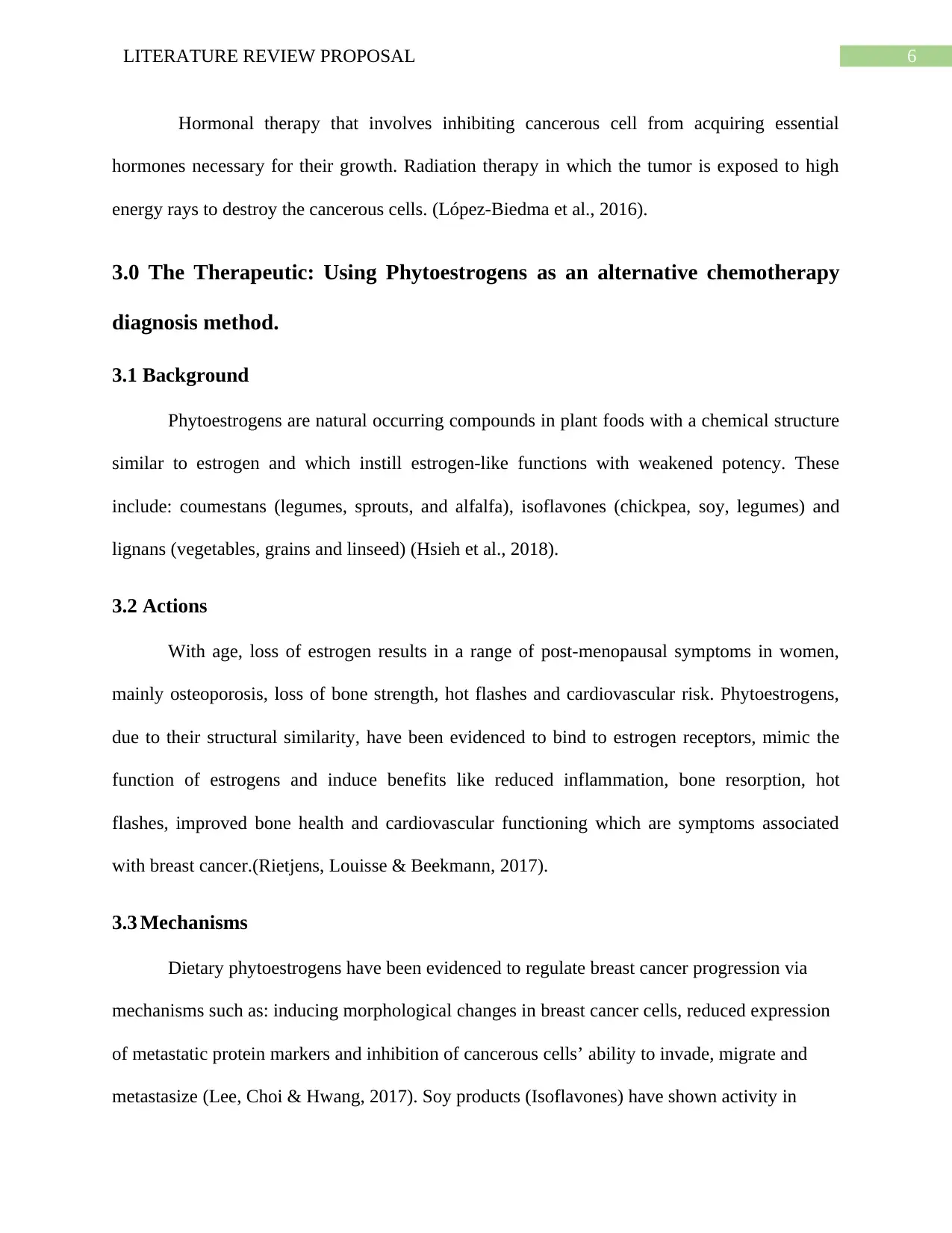
6LITERATURE REVIEW PROPOSAL
Hormonal therapy that involves inhibiting cancerous cell from acquiring essential
hormones necessary for their growth. Radiation therapy in which the tumor is exposed to high
energy rays to destroy the cancerous cells. (López-Biedma et al., 2016).
3.0 The Therapeutic: Using Phytoestrogens as an alternative chemotherapy
diagnosis method.
3.1 Background
Phytoestrogens are natural occurring compounds in plant foods with a chemical structure
similar to estrogen and which instill estrogen-like functions with weakened potency. These
include: coumestans (legumes, sprouts, and alfalfa), isoflavones (chickpea, soy, legumes) and
lignans (vegetables, grains and linseed) (Hsieh et al., 2018).
3.2 Actions
With age, loss of estrogen results in a range of post-menopausal symptoms in women,
mainly osteoporosis, loss of bone strength, hot flashes and cardiovascular risk. Phytoestrogens,
due to their structural similarity, have been evidenced to bind to estrogen receptors, mimic the
function of estrogens and induce benefits like reduced inflammation, bone resorption, hot
flashes, improved bone health and cardiovascular functioning which are symptoms associated
with breast cancer.(Rietjens, Louisse & Beekmann, 2017).
3.3 Mechanisms
Dietary phytoestrogens have been evidenced to regulate breast cancer progression via
mechanisms such as: inducing morphological changes in breast cancer cells, reduced expression
of metastatic protein markers and inhibition of cancerous cells’ ability to invade, migrate and
metastasize (Lee, Choi & Hwang, 2017). Soy products (Isoflavones) have shown activity in
Hormonal therapy that involves inhibiting cancerous cell from acquiring essential
hormones necessary for their growth. Radiation therapy in which the tumor is exposed to high
energy rays to destroy the cancerous cells. (López-Biedma et al., 2016).
3.0 The Therapeutic: Using Phytoestrogens as an alternative chemotherapy
diagnosis method.
3.1 Background
Phytoestrogens are natural occurring compounds in plant foods with a chemical structure
similar to estrogen and which instill estrogen-like functions with weakened potency. These
include: coumestans (legumes, sprouts, and alfalfa), isoflavones (chickpea, soy, legumes) and
lignans (vegetables, grains and linseed) (Hsieh et al., 2018).
3.2 Actions
With age, loss of estrogen results in a range of post-menopausal symptoms in women,
mainly osteoporosis, loss of bone strength, hot flashes and cardiovascular risk. Phytoestrogens,
due to their structural similarity, have been evidenced to bind to estrogen receptors, mimic the
function of estrogens and induce benefits like reduced inflammation, bone resorption, hot
flashes, improved bone health and cardiovascular functioning which are symptoms associated
with breast cancer.(Rietjens, Louisse & Beekmann, 2017).
3.3 Mechanisms
Dietary phytoestrogens have been evidenced to regulate breast cancer progression via
mechanisms such as: inducing morphological changes in breast cancer cells, reduced expression
of metastatic protein markers and inhibition of cancerous cells’ ability to invade, migrate and
metastasize (Lee, Choi & Hwang, 2017). Soy products (Isoflavones) have shown activity in
Paraphrase This Document
Need a fresh take? Get an instant paraphrase of this document with our AI Paraphraser

7LITERATURE REVIEW PROPOSAL
breast cancer management and regulation as they act as estrogens and bind to estrogen receptors.
Genistein cause apoptosis of breast cancer tumor cells when they bind to estrogen receptor active
sites, (Fritz et al. 2013).
breast cancer management and regulation as they act as estrogens and bind to estrogen receptors.
Genistein cause apoptosis of breast cancer tumor cells when they bind to estrogen receptor active
sites, (Fritz et al. 2013).
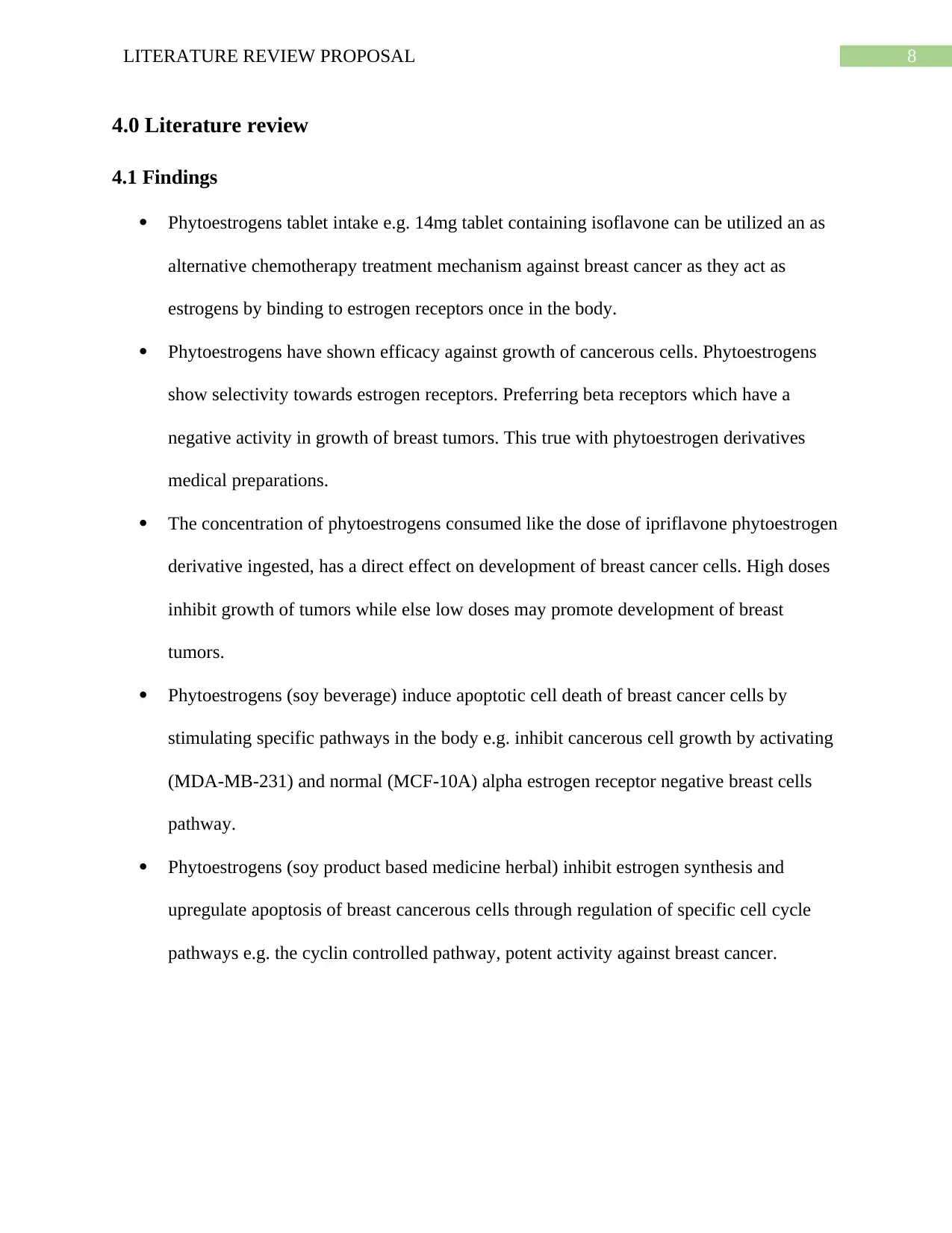
8LITERATURE REVIEW PROPOSAL
4.0 Literature review
4.1 Findings
Phytoestrogens tablet intake e.g. 14mg tablet containing isoflavone can be utilized an as
alternative chemotherapy treatment mechanism against breast cancer as they act as
estrogens by binding to estrogen receptors once in the body.
Phytoestrogens have shown efficacy against growth of cancerous cells. Phytoestrogens
show selectivity towards estrogen receptors. Preferring beta receptors which have a
negative activity in growth of breast tumors. This true with phytoestrogen derivatives
medical preparations.
The concentration of phytoestrogens consumed like the dose of ipriflavone phytoestrogen
derivative ingested, has a direct effect on development of breast cancer cells. High doses
inhibit growth of tumors while else low doses may promote development of breast
tumors.
Phytoestrogens (soy beverage) induce apoptotic cell death of breast cancer cells by
stimulating specific pathways in the body e.g. inhibit cancerous cell growth by activating
(MDA-MB-231) and normal (MCF-10A) alpha estrogen receptor negative breast cells
pathway.
Phytoestrogens (soy product based medicine herbal) inhibit estrogen synthesis and
upregulate apoptosis of breast cancerous cells through regulation of specific cell cycle
pathways e.g. the cyclin controlled pathway, potent activity against breast cancer.
4.0 Literature review
4.1 Findings
Phytoestrogens tablet intake e.g. 14mg tablet containing isoflavone can be utilized an as
alternative chemotherapy treatment mechanism against breast cancer as they act as
estrogens by binding to estrogen receptors once in the body.
Phytoestrogens have shown efficacy against growth of cancerous cells. Phytoestrogens
show selectivity towards estrogen receptors. Preferring beta receptors which have a
negative activity in growth of breast tumors. This true with phytoestrogen derivatives
medical preparations.
The concentration of phytoestrogens consumed like the dose of ipriflavone phytoestrogen
derivative ingested, has a direct effect on development of breast cancer cells. High doses
inhibit growth of tumors while else low doses may promote development of breast
tumors.
Phytoestrogens (soy beverage) induce apoptotic cell death of breast cancer cells by
stimulating specific pathways in the body e.g. inhibit cancerous cell growth by activating
(MDA-MB-231) and normal (MCF-10A) alpha estrogen receptor negative breast cells
pathway.
Phytoestrogens (soy product based medicine herbal) inhibit estrogen synthesis and
upregulate apoptosis of breast cancerous cells through regulation of specific cell cycle
pathways e.g. the cyclin controlled pathway, potent activity against breast cancer.
⊘ This is a preview!⊘
Do you want full access?
Subscribe today to unlock all pages.

Trusted by 1+ million students worldwide
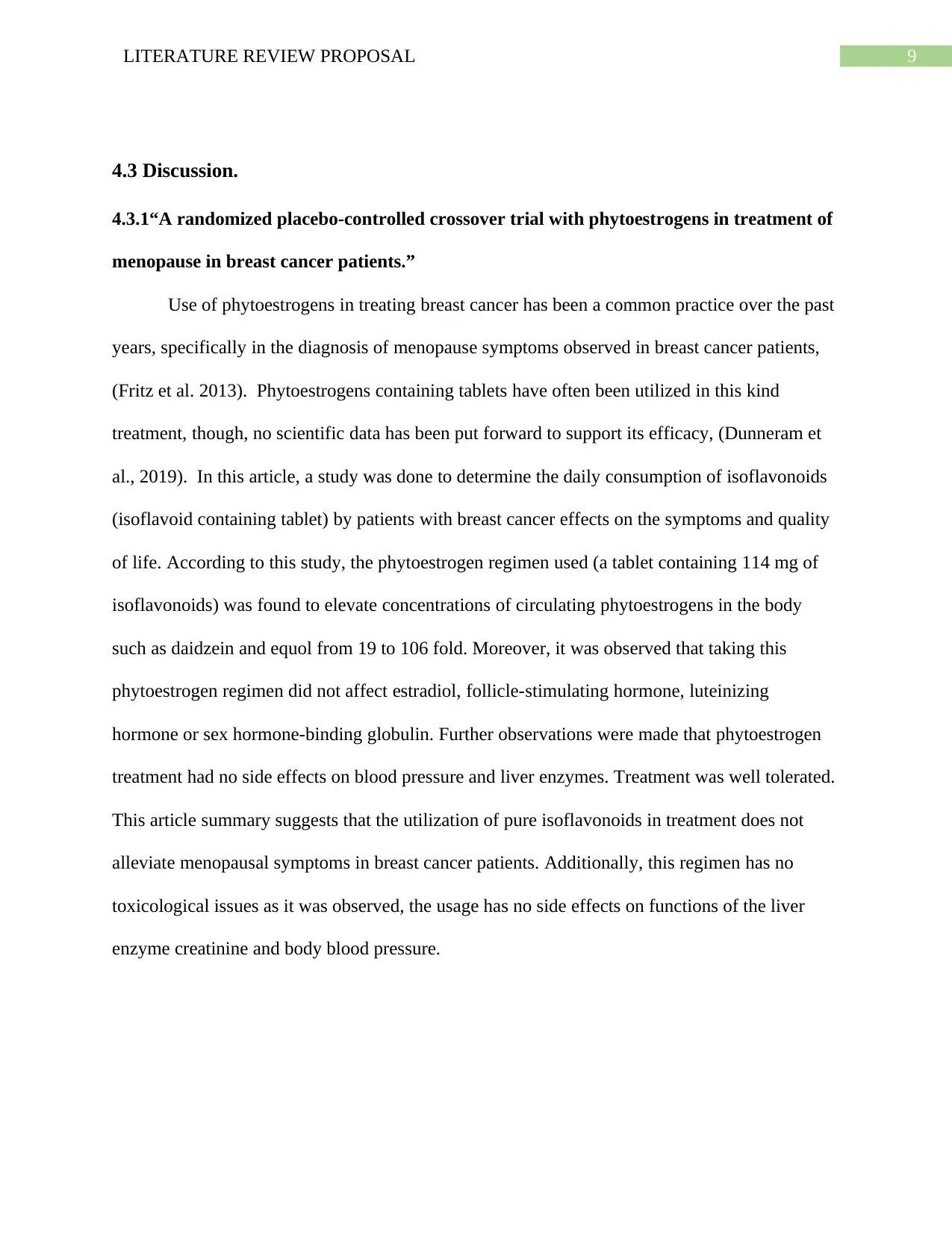
9LITERATURE REVIEW PROPOSAL
4.3 Discussion.
4.3.1“A randomized placebo-controlled crossover trial with phytoestrogens in treatment of
menopause in breast cancer patients.”
Use of phytoestrogens in treating breast cancer has been a common practice over the past
years, specifically in the diagnosis of menopause symptoms observed in breast cancer patients,
(Fritz et al. 2013). Phytoestrogens containing tablets have often been utilized in this kind
treatment, though, no scientific data has been put forward to support its efficacy, (Dunneram et
al., 2019). In this article, a study was done to determine the daily consumption of isoflavonoids
(isoflavoid containing tablet) by patients with breast cancer effects on the symptoms and quality
of life. According to this study, the phytoestrogen regimen used (a tablet containing 114 mg of
isoflavonoids) was found to elevate concentrations of circulating phytoestrogens in the body
such as daidzein and equol from 19 to 106 fold. Moreover, it was observed that taking this
phytoestrogen regimen did not affect estradiol, follicle-stimulating hormone, luteinizing
hormone or sex hormone-binding globulin. Further observations were made that phytoestrogen
treatment had no side effects on blood pressure and liver enzymes. Treatment was well tolerated.
This article summary suggests that the utilization of pure isoflavonoids in treatment does not
alleviate menopausal symptoms in breast cancer patients. Additionally, this regimen has no
toxicological issues as it was observed, the usage has no side effects on functions of the liver
enzyme creatinine and body blood pressure.
4.3 Discussion.
4.3.1“A randomized placebo-controlled crossover trial with phytoestrogens in treatment of
menopause in breast cancer patients.”
Use of phytoestrogens in treating breast cancer has been a common practice over the past
years, specifically in the diagnosis of menopause symptoms observed in breast cancer patients,
(Fritz et al. 2013). Phytoestrogens containing tablets have often been utilized in this kind
treatment, though, no scientific data has been put forward to support its efficacy, (Dunneram et
al., 2019). In this article, a study was done to determine the daily consumption of isoflavonoids
(isoflavoid containing tablet) by patients with breast cancer effects on the symptoms and quality
of life. According to this study, the phytoestrogen regimen used (a tablet containing 114 mg of
isoflavonoids) was found to elevate concentrations of circulating phytoestrogens in the body
such as daidzein and equol from 19 to 106 fold. Moreover, it was observed that taking this
phytoestrogen regimen did not affect estradiol, follicle-stimulating hormone, luteinizing
hormone or sex hormone-binding globulin. Further observations were made that phytoestrogen
treatment had no side effects on blood pressure and liver enzymes. Treatment was well tolerated.
This article summary suggests that the utilization of pure isoflavonoids in treatment does not
alleviate menopausal symptoms in breast cancer patients. Additionally, this regimen has no
toxicological issues as it was observed, the usage has no side effects on functions of the liver
enzyme creatinine and body blood pressure.
Paraphrase This Document
Need a fresh take? Get an instant paraphrase of this document with our AI Paraphraser
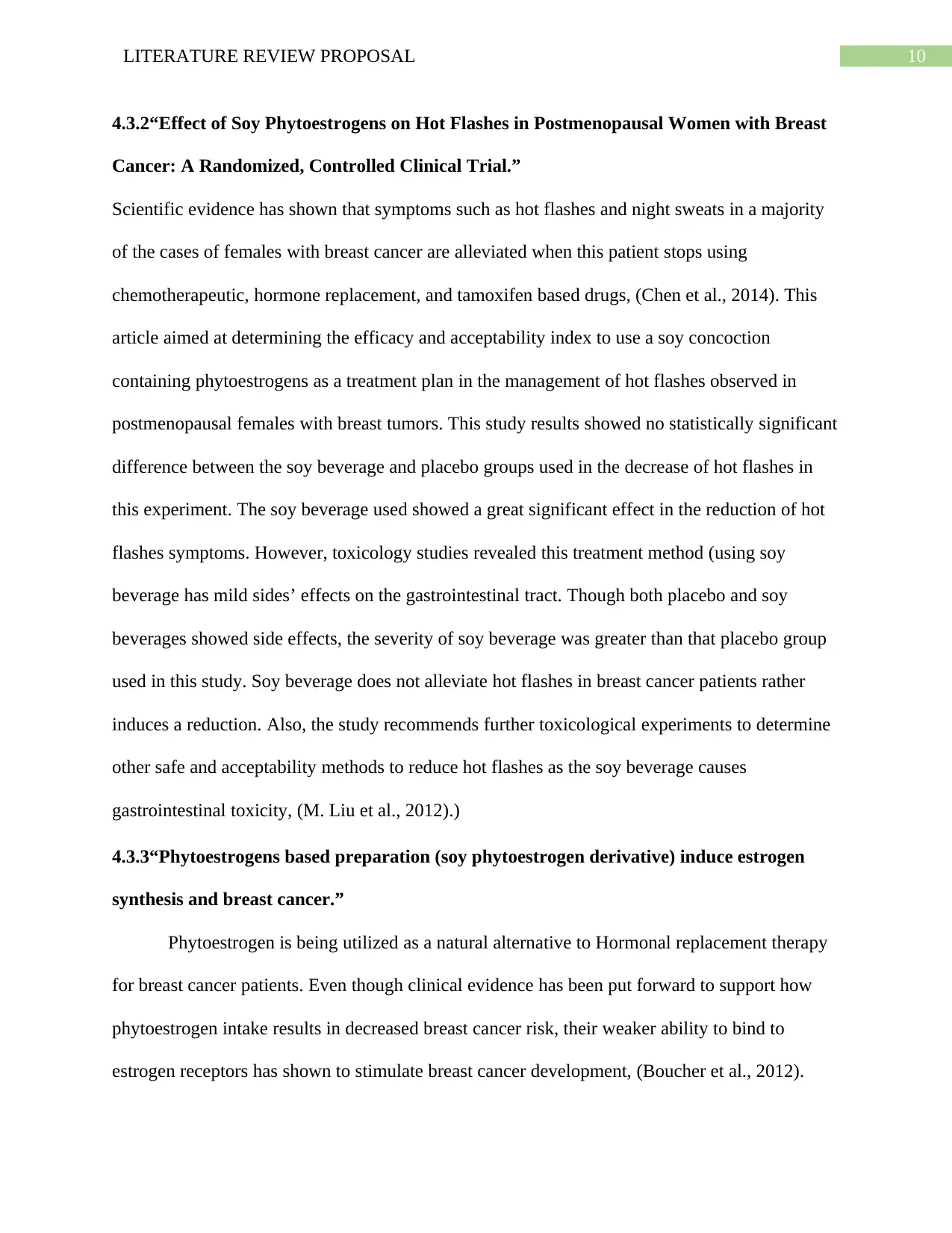
10LITERATURE REVIEW PROPOSAL
4.3.2“Effect of Soy Phytoestrogens on Hot Flashes in Postmenopausal Women with Breast
Cancer: A Randomized, Controlled Clinical Trial.”
Scientific evidence has shown that symptoms such as hot flashes and night sweats in a majority
of the cases of females with breast cancer are alleviated when this patient stops using
chemotherapeutic, hormone replacement, and tamoxifen based drugs, (Chen et al., 2014). This
article aimed at determining the efficacy and acceptability index to use a soy concoction
containing phytoestrogens as a treatment plan in the management of hot flashes observed in
postmenopausal females with breast tumors. This study results showed no statistically significant
difference between the soy beverage and placebo groups used in the decrease of hot flashes in
this experiment. The soy beverage used showed a great significant effect in the reduction of hot
flashes symptoms. However, toxicology studies revealed this treatment method (using soy
beverage has mild sides’ effects on the gastrointestinal tract. Though both placebo and soy
beverages showed side effects, the severity of soy beverage was greater than that placebo group
used in this study. Soy beverage does not alleviate hot flashes in breast cancer patients rather
induces a reduction. Also, the study recommends further toxicological experiments to determine
other safe and acceptability methods to reduce hot flashes as the soy beverage causes
gastrointestinal toxicity, (M. Liu et al., 2012).)
4.3.3“Phytoestrogens based preparation (soy phytoestrogen derivative) induce estrogen
synthesis and breast cancer.”
Phytoestrogen is being utilized as a natural alternative to Hormonal replacement therapy
for breast cancer patients. Even though clinical evidence has been put forward to support how
phytoestrogen intake results in decreased breast cancer risk, their weaker ability to bind to
estrogen receptors has shown to stimulate breast cancer development, (Boucher et al., 2012).
4.3.2“Effect of Soy Phytoestrogens on Hot Flashes in Postmenopausal Women with Breast
Cancer: A Randomized, Controlled Clinical Trial.”
Scientific evidence has shown that symptoms such as hot flashes and night sweats in a majority
of the cases of females with breast cancer are alleviated when this patient stops using
chemotherapeutic, hormone replacement, and tamoxifen based drugs, (Chen et al., 2014). This
article aimed at determining the efficacy and acceptability index to use a soy concoction
containing phytoestrogens as a treatment plan in the management of hot flashes observed in
postmenopausal females with breast tumors. This study results showed no statistically significant
difference between the soy beverage and placebo groups used in the decrease of hot flashes in
this experiment. The soy beverage used showed a great significant effect in the reduction of hot
flashes symptoms. However, toxicology studies revealed this treatment method (using soy
beverage has mild sides’ effects on the gastrointestinal tract. Though both placebo and soy
beverages showed side effects, the severity of soy beverage was greater than that placebo group
used in this study. Soy beverage does not alleviate hot flashes in breast cancer patients rather
induces a reduction. Also, the study recommends further toxicological experiments to determine
other safe and acceptability methods to reduce hot flashes as the soy beverage causes
gastrointestinal toxicity, (M. Liu et al., 2012).)
4.3.3“Phytoestrogens based preparation (soy phytoestrogen derivative) induce estrogen
synthesis and breast cancer.”
Phytoestrogen is being utilized as a natural alternative to Hormonal replacement therapy
for breast cancer patients. Even though clinical evidence has been put forward to support how
phytoestrogen intake results in decreased breast cancer risk, their weaker ability to bind to
estrogen receptors has shown to stimulate breast cancer development, (Boucher et al., 2012).
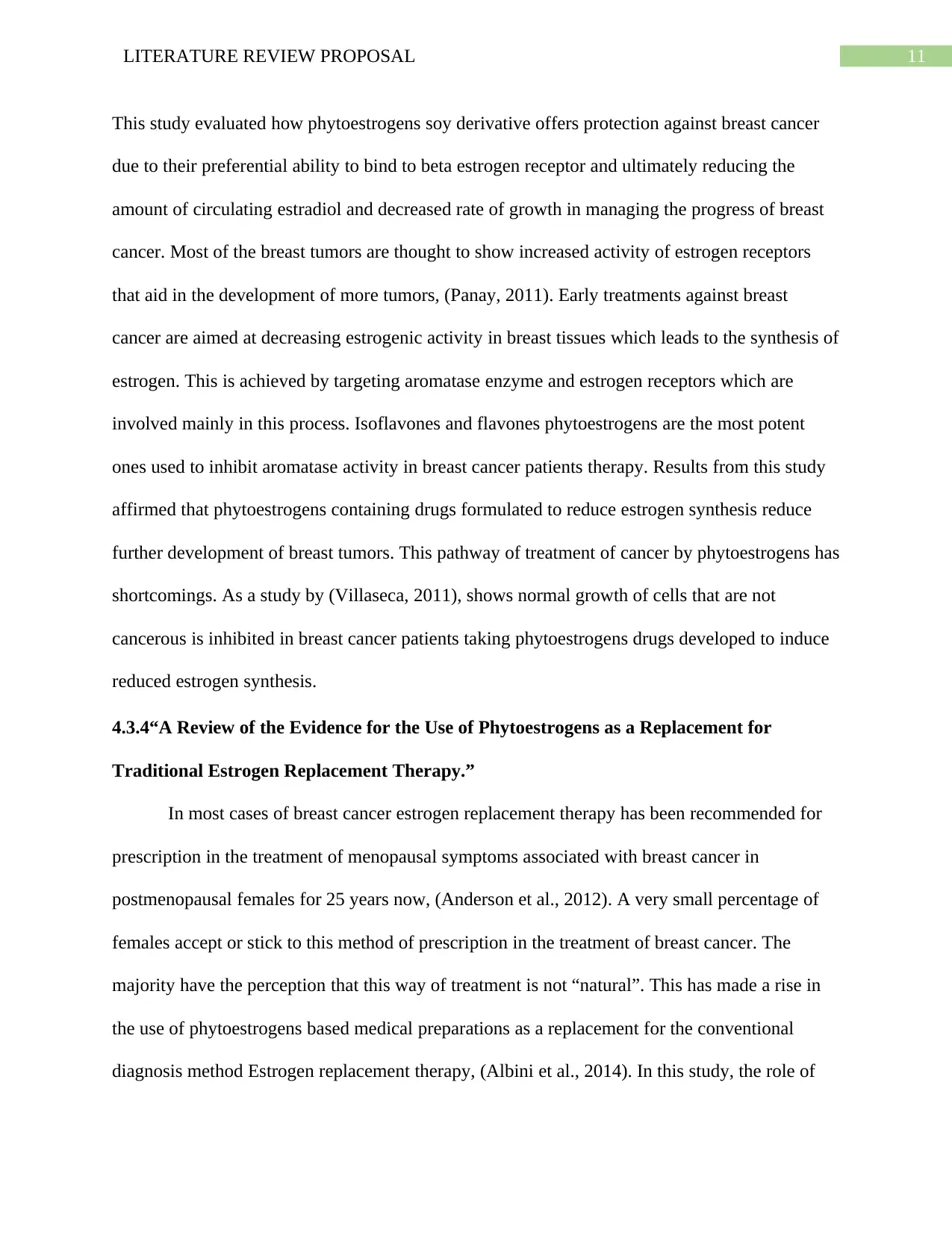
11LITERATURE REVIEW PROPOSAL
This study evaluated how phytoestrogens soy derivative offers protection against breast cancer
due to their preferential ability to bind to beta estrogen receptor and ultimately reducing the
amount of circulating estradiol and decreased rate of growth in managing the progress of breast
cancer. Most of the breast tumors are thought to show increased activity of estrogen receptors
that aid in the development of more tumors, (Panay, 2011). Early treatments against breast
cancer are aimed at decreasing estrogenic activity in breast tissues which leads to the synthesis of
estrogen. This is achieved by targeting aromatase enzyme and estrogen receptors which are
involved mainly in this process. Isoflavones and flavones phytoestrogens are the most potent
ones used to inhibit aromatase activity in breast cancer patients therapy. Results from this study
affirmed that phytoestrogens containing drugs formulated to reduce estrogen synthesis reduce
further development of breast tumors. This pathway of treatment of cancer by phytoestrogens has
shortcomings. As a study by (Villaseca, 2011), shows normal growth of cells that are not
cancerous is inhibited in breast cancer patients taking phytoestrogens drugs developed to induce
reduced estrogen synthesis.
4.3.4“A Review of the Evidence for the Use of Phytoestrogens as a Replacement for
Traditional Estrogen Replacement Therapy.”
In most cases of breast cancer estrogen replacement therapy has been recommended for
prescription in the treatment of menopausal symptoms associated with breast cancer in
postmenopausal females for 25 years now, (Anderson et al., 2012). A very small percentage of
females accept or stick to this method of prescription in the treatment of breast cancer. The
majority have the perception that this way of treatment is not “natural”. This has made a rise in
the use of phytoestrogens based medical preparations as a replacement for the conventional
diagnosis method Estrogen replacement therapy, (Albini et al., 2014). In this study, the role of
This study evaluated how phytoestrogens soy derivative offers protection against breast cancer
due to their preferential ability to bind to beta estrogen receptor and ultimately reducing the
amount of circulating estradiol and decreased rate of growth in managing the progress of breast
cancer. Most of the breast tumors are thought to show increased activity of estrogen receptors
that aid in the development of more tumors, (Panay, 2011). Early treatments against breast
cancer are aimed at decreasing estrogenic activity in breast tissues which leads to the synthesis of
estrogen. This is achieved by targeting aromatase enzyme and estrogen receptors which are
involved mainly in this process. Isoflavones and flavones phytoestrogens are the most potent
ones used to inhibit aromatase activity in breast cancer patients therapy. Results from this study
affirmed that phytoestrogens containing drugs formulated to reduce estrogen synthesis reduce
further development of breast tumors. This pathway of treatment of cancer by phytoestrogens has
shortcomings. As a study by (Villaseca, 2011), shows normal growth of cells that are not
cancerous is inhibited in breast cancer patients taking phytoestrogens drugs developed to induce
reduced estrogen synthesis.
4.3.4“A Review of the Evidence for the Use of Phytoestrogens as a Replacement for
Traditional Estrogen Replacement Therapy.”
In most cases of breast cancer estrogen replacement therapy has been recommended for
prescription in the treatment of menopausal symptoms associated with breast cancer in
postmenopausal females for 25 years now, (Anderson et al., 2012). A very small percentage of
females accept or stick to this method of prescription in the treatment of breast cancer. The
majority have the perception that this way of treatment is not “natural”. This has made a rise in
the use of phytoestrogens based medical preparations as a replacement for the conventional
diagnosis method Estrogen replacement therapy, (Albini et al., 2014). In this study, the role of
⊘ This is a preview!⊘
Do you want full access?
Subscribe today to unlock all pages.

Trusted by 1+ million students worldwide
1 out of 21
Your All-in-One AI-Powered Toolkit for Academic Success.
+13062052269
info@desklib.com
Available 24*7 on WhatsApp / Email
![[object Object]](/_next/static/media/star-bottom.7253800d.svg)
Unlock your academic potential
Copyright © 2020–2025 A2Z Services. All Rights Reserved. Developed and managed by ZUCOL.